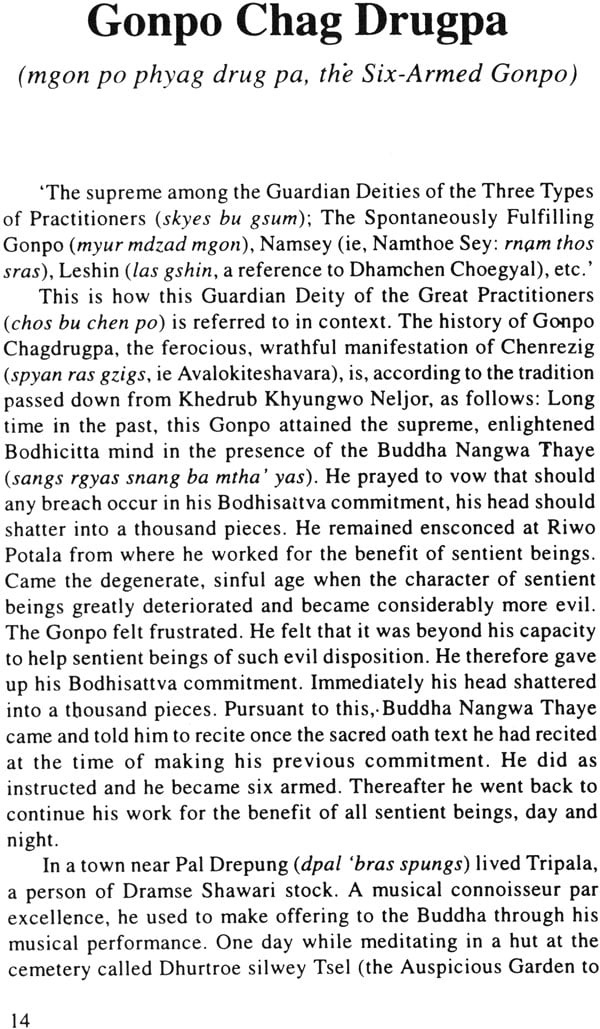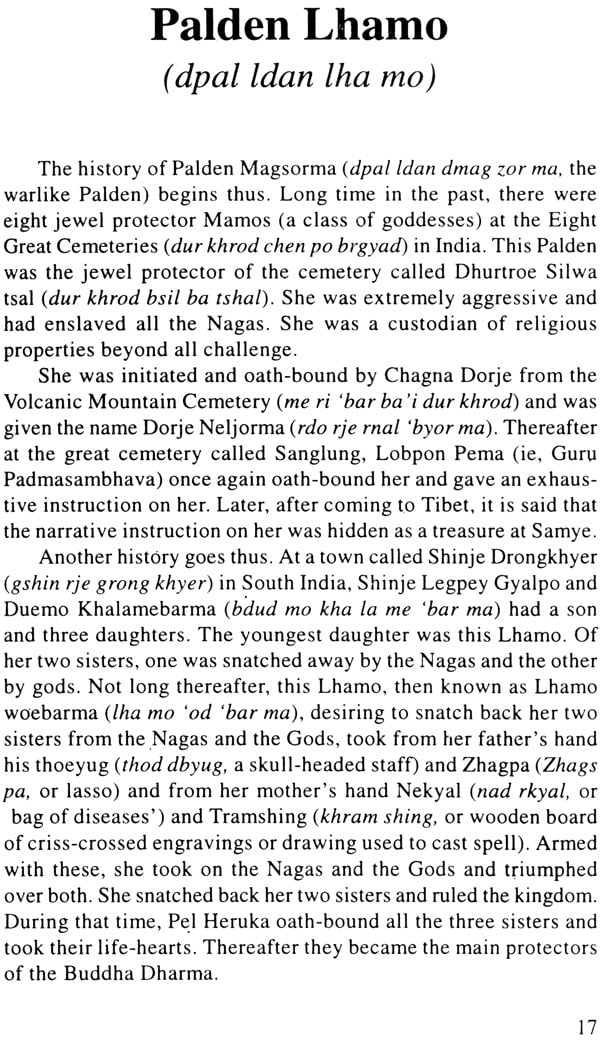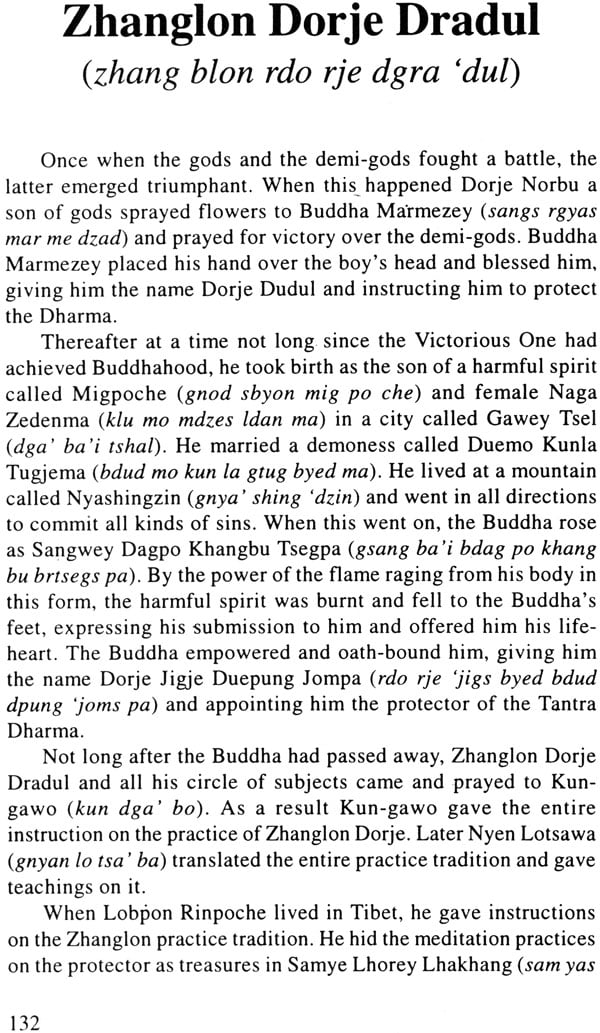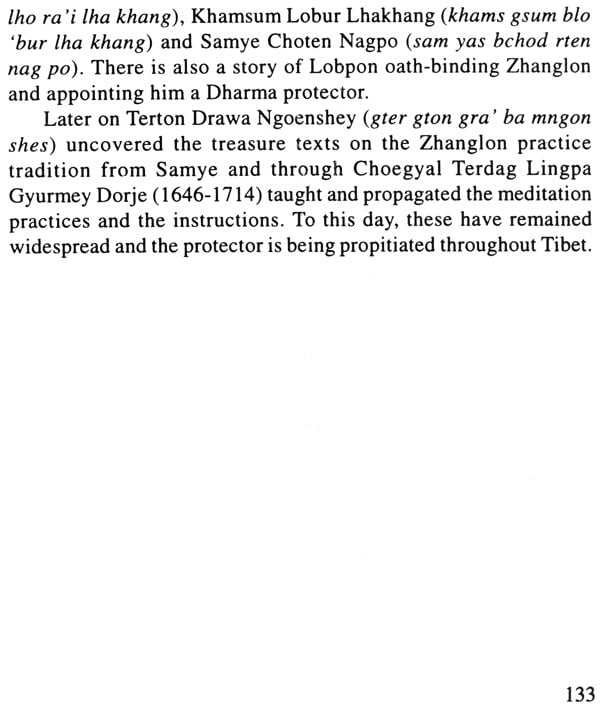
The Guardian Deities of Tibet
Book Specification
| Item Code: | NAB014 |
| Author: | Ladrang Kalsang |
| Publisher: | WINSOME BOOKS INDIA |
| Language: | English |
| Edition: | 2000 |
| ISBN: | 8188043044 |
| Pages: | 133 (30 Line Drawing) |
| Cover: | Paperback |
| Other Details | 8.4"x 5.4" |
| Weight | 190 gm |
Book Description
The great many religious traditions that have come down to us through our benevolent ancestors are the pride of the Tibetan people in the world community. But through the vicissitudes of time these seem to have declined over the periods. Particularly in the case of the Guardian Deities (srung ma) strictest secrecy was observed by the Lamas who passed their respective traditions down only to their 'heart sons'. This was the manner in which the tradition was passed down through the generations. The ordinary members of the public had therefore very little familiarity with the history of individual Guardian Deities. I therefore felt an urge to make a brief compilation of the histories of the Guardian Deities of the Dharma (chos skyong) that would enable one to gain an immediate knowledge of each of them. In the course of searching for documents to start my research I stumbled upon a book titled 'the Complete Literary Works of Jedrung Zhepey Dorje ' (rje drung bzhad pa'i rdo rje 'i gsung 'bum) in which a book titled 'Collected Biographies of Guardians of the Faith' (bstan srung rgya mtsho'i rnam thar) was cited. This gave a stimulating fillip to my interest in undertaking the research and I earnestly began my work.
Making a careful study of that document, I found that its coverage of the subject was more detailed and expansive than ever before. It was a testamentary of a skilled research carried out over many years. But though undoubtedly a good work in every respect, its wordings were in the esoteric language of hidden treasure-texts and antiquated orthography. It was ill-suited for the general body of modern readers in many respects. I therefore simplified the verbostic terms by gleaning their essence. As regards those giving cause for doubt and those requiring reference to other texts, I went to the relevant sources and made perseverant efforts to uncover the meanings.
I did not take for granted the sources cited in the document but opened those very works to verify them. In the course of doing that I found that the main bases of this work were those mentioned in Rinchen Terdzod and hidden treasure-texts. In the work in question the Guardians of Religion are arranged in order of their antiquity. However some of them lack clarity for reasons of their philosophica! theories and I made this up by making comparative reference to other texts. Regarding the reference materials them- selves I did not open each and every text on oblation offering rituals (gtor chog), .propitiation (bskang gso}, invocation (asol kha), etc. that I could get hold of, but rather on the basis of the order of the antiquity of the Guardians and the antiquity of the hidden treasure-texts in reference to each one of them.
From perusing Bashe (rba bzhed); Gyalpoe Kathang (rgyal po 'i bka' thang, the hidden treasure-text of Ogyen Lingpa); Gurue Namthar Zanglingma (gu ru 'i rnam thar zangs gling ma, the hidden treasure-text known to be uncovered by Ngadag Nyangben), and Lhadre Khathang (lha 'dre bka' thang, a hidden treasure text of Ogyen Lingpa), I found more than 40 different Guardian Deities mentioned by name. However I have taken only some of them who are well known. In regard to some I found no records as they are guarded secrets passed down only by words of mouth from the lamas to their root disciples. I left these subjects of 'whispered lineage' as they are. There are some regarding which supplementary information have been added from the source-texts for their invocation.
Though there is a great need to include the histories of more Guardians such as the Nine Gods of Tibet (srid pa chags pa 'i [ha dgu) and the Thirteen Kingly Guardians (rje yi mgur lha bcu gsum), I did not see any authentic source for these. It may also be mentioned that the Thirteen Kingly Guardians consist of the Nine Gods of Tibet in addition to four others (mentioned later on in this book). They are therefore not a new set of Guardian Deities. In writing this book I therefore let remain as they are those which had originated from the Yungdrung Bon religious histories. Nevertheless, apart from the mention that they were sons of Wodey Gunggyal ('0 de gung rgyal) there are no separate histories of each individual Guardian Deity. Be that as it may, the Thang-yig, Bashe, etc. throw light only on Yarlha Shampo,. Nyenchen Thanglha, and the like and no others. I therefore wrote this separate book to cater to a contemporary widespread interest.
There are many traditional explanations regarding the Gonpo class of Guardians. In particular, different schools or sects have their own traditional symbolisms, complexions and histories for them which are at variance from one another. Nevertheless, for the purpose of this book I have followed the authentic work of All-Knowing Sonam Gyatso. An essence of it has been separately extracted. I have seen in Tibet a catalogue of Narrative Instructions on Gonpo (mgon po 'i chos skor). It contained titles of one hundred and twenty-four different Narrative Instructions (chos skor). I do not know whether all of them could be found today. But the details about the Narrative Instruction on Gonpo are as found in Rinchen Terzod (rin chen gter mdzod). But since 'mgon po'i be'u bam' was later written by Khedrup Thamche Khyenpa, it became the most authentic work amongst all the Narrative Instructions on Gonpo.
Though I have seen the Crow-Faced Gonpo (mgon po bya rog gdong can) and the Four-Armed Gonpo (phyag bzhi pa) being combined into one and, likewise, the Four-Faced and the Four- Armed Gonpos being combined into one, and many other such unseemly things, I have taken the universality of acceptance as the criterion for inclusion here.
Some narrations state that Tsering Che-nga (tshe ring mched lnga) and Tenma Chu-nyi (bstan ma bcu gnyis, the twelve female Dharma Protectors of Tibet) are not separate. However the universal treatment is otherwise. Because I have seen no other more illuminating source for Tsering Che-nga than the biography of Milarepa (mi la ras pa'i rnam mgur), I have followed that. biography in-lyrical-form as the source. Some sources speak of different origins of each individual deity. Nevertheless I have followed Milarepa's biography here.
Having assumed that Pehar and Nechung Dorje Dregden (gnas chung rdo rje dregs ldan) were different characters, I carried out an indepth research. But I found that the later is onlya speech miracle-emanation of the former; I found no evidence that it is a separate entity on its own. Because of this, the history of Nechung Dorje Dregden should be understood as a part of the history of Pehar Gyalpo.
Some Guardian Deities, such as the Tenma Chu-nyi (bstan ma bcu gnyis), do not have firm historical bases but only such things as texts of propitiation (bskang gso) and eulogies (bstod tsogs), But because they constitute the early Local Deities (yul lha) of Tibet, I recorded them here by making a comparative study of Tendoe Chi-kyi Gyalmoe Luyang (brtan mdos dpyid kyi rgyal mo'i glu dbyangs) written by His Holiness the Fifth Dalai Lama and Gyag-ngen (brgyags brngan) renowned to have been authored by Lobpon Pema. Nevertheless, I found great many inconsistencies regarding the character; history; emblems, implements and hand gestures, and the mounting animals of each one of them. For greater details, therefore, one should look at the relevant source-texts of the respective deities. Yudronma (gyu sgron ma) is shown in some texts as something of the main deity of Tenma Chu-nyi. Some other texts, however, show her as altogether separate from Tenma Chu- nyi. Whatever be the case, Yudronma herself being the focus, I have written her history separately. In addition, I had a feeling that in some of the sources there had been mistakes in the writing of the names of each of the twelve deities of Tenma Chu-nyi. I therefore left the previous texts as they are.
I saw it as necessary that writing the histories of the Guardian Deities require more care and depth of research than writing other histories. Therefore since writing the first draft text, I made four reviews and revisions. After each revision I showed the text to the elderly and experienced experts. Their suggestions were duly incorporated for a yet another revised text.
This book titled "The Guardian Deities of Tibet" was written in view of the fact that it has hitherto been hard to come across histories of the religious Guardian Deities of Tibet. The available texts are in antiquated orthography and lack appropriate length. I therefore embarked on this project on 2 October 1995, worked on it during times I could spare outside my office work and finally completed it at Dharamsala on 15 January 1996.
| Preface | 7 |
| Gonpo Chagdrug (mgon po phyag drug, the six armed Gonpo) | 14 |
| Palden Lhamo (dpal idan lha mo) | 17 |
| Gonpo Zhal Zhipa (mgon po Zhal bzhi pa, the Four-Faced Gonpo) | 33 |
| Gonpo Chag Zhipa (mgon po phyag bzhi pa, the Four-Armed Gonpo) | 37 |
| Dhamchen Choegyal (dam can chos rgyal) | 43 |
| Gyalpo Namthoe Sey (rgyal po rnam thos sras) | 46 |
| Gyalchen Dezhi (rgyal chen sde bzhi) | 52 |
| Tsogdag Langnachen (tshogs bdag glang sna can) | 55 |
| Tenma Chu-nyi (brtan ma bcu gnyis) | 57 |
| Nechung Dorje Dregden (gnas chung rdo rje dregs ldan) | 77 |
| Lhachen Tsangpa Karpo (lha chen tshangs pa dkar po) | 86 |
| Nyenchen Thanglha (gnyan chen thang lha) | 92 |
| Tashi Tsering Che-nga (bkra shis tshe ring mched lnga) | 95 |
| Bhegtse (beg rtse) | 104 |
| Dhamchen Dorje Legpa (dam can rdo rje legs pa) | 109 |
| Tsiu Mhar (rtsi'u dmar) | 114 |
| Dorje Yudronma (rdo rje gyu sgron ma) | 117 |
| Sipa Chagpey Lhagu (srid pa chags pa'i lha dgu) | 119 |
| Mhachen Pomra (rma chen spom ra) | 124 |
| Yarlha Shampo (yar lha sham po) | 128 |
| Luyi Gyalpo Nele Thoekar (klu'I rgyal po ne le thod dkar) | 130 |
| Zhanglon Dorje Dadul (Zhang blon rdo rje dgra 'dul) | 132 |













